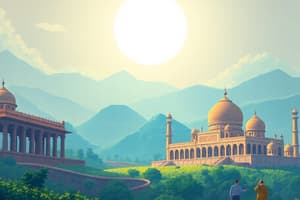Podcast
Questions and Answers
What are the common goals of India's five-year plans?
What are the common goals of India's five-year plans?
- Modernisation, trade expansion, self-sufficiency, and profit maximization
- Growth, modernisation, self-sufficiency, and equity (correct)
- Equity, employment generation, environmental sustainability, and growth
- Growth, inflation control, self-sufficiency, and equity
Why was the Green Revolution implemented in India?
Why was the Green Revolution implemented in India?
- To decrease the dependency on agriculture
- To increase industrial production
- To ensure food security and self-sufficiency (correct)
- To promote export-driven agriculture
What was one major drawback of the public sector during India's planning period?
What was one major drawback of the public sector during India's planning period?
- Inefficient functioning leading to financial losses (correct)
- Overexpansion into the service sector
- Complete reliance on private investment
- Rapid growth without sustainability measures
Why is self-reliance considered a necessary planning objective for a developing country like India?
Why is self-reliance considered a necessary planning objective for a developing country like India?
What does 'growth with equity' as a planning objective emphasize?
What does 'growth with equity' as a planning objective emphasize?
What type of land reforms were mainly implemented in India to benefit agriculture?
What type of land reforms were mainly implemented in India to benefit agriculture?
What was the impact of high-yielding variety (HYV) seeds during the Green Revolution?
What was the impact of high-yielding variety (HYV) seeds during the Green Revolution?
What does the import substitution policy aim to achieve?
What does the import substitution policy aim to achieve?
What are the key questions that the Five-Year Plans of India aimed to address regarding the national economy?
What are the key questions that the Five-Year Plans of India aimed to address regarding the national economy?
A group of students conducting a case study on an agricultural farm should focus on which of these to understand the farming practices?
A group of students conducting a case study on an agricultural farm should focus on which of these to understand the farming practices?
What is the primary objective of comparing the cost of production, productivity, and income earned by different farming families?
What is the primary objective of comparing the cost of production, productivity, and income earned by different farming families?
Why is it significant to collect newspaper clippings and discuss views of developed and developing countries on farm subsidies?
Why is it significant to collect newspaper clippings and discuss views of developed and developing countries on farm subsidies?
Which of the following is a key argument in favor of agricultural subsidies?
Which of the following is a key argument in favor of agricultural subsidies?
What is a potential argument against agricultural subsidies?
What is a potential argument against agricultural subsidies?
What is the primary purpose of studying arguments for and against agricultural subsidies?
What is the primary purpose of studying arguments for and against agricultural subsidies?
Flashcards
Mixed Economy Model
Mixed Economy Model
An economic system combining features of socialism and capitalism.
Five Year Plans
Five Year Plans
Strategic economic plans formulated in India for growth and development every five years.
Green Revolution
Green Revolution
Agricultural movement to increase food production using high-yield seeds and modern techniques.
High Yielding Variety (HYV) Seeds
High Yielding Variety (HYV) Seeds
Signup and view all the flashcards
Import Substitution Policy
Import Substitution Policy
Signup and view all the flashcards
Marketable Surplus
Marketable Surplus
Signup and view all the flashcards
Land Reforms
Land Reforms
Signup and view all the flashcards
Growth with Equity
Growth with Equity
Signup and view all the flashcards
Development Policies
Development Policies
Signup and view all the flashcards
Regulated Economy
Regulated Economy
Signup and view all the flashcards
Production Decisions
Production Decisions
Signup and view all the flashcards
Agricultural Study
Agricultural Study
Signup and view all the flashcards
Occupational Structure
Occupational Structure
Signup and view all the flashcards
Agricultural Subsidies
Agricultural Subsidies
Signup and view all the flashcards
International Organizations
International Organizations
Signup and view all the flashcards
Study Notes
Indian Economy 1950-1990
- Learners will understand India's five-year plans, development policies (agriculture and industry) from 1950-1990, and the merits/limitations of a regulated economy.
- India gained independence on August 15, 1947.
- Leaders sought an economic system promoting national welfare, rather than concentrating on a select few.
- Socialism appealed to Jawaharlal Nehru, but not the Soviet Union's model of state-owned production.
- Nehru and other leaders sought an alternative to extreme forms of capitalism and socialism.
- Key goals of five-year plans included: growth, self-reliance, and modernization.
- The proportion of agricultural GDP diminished, while the service sector grew.
- Structural change occurred, and the proportion of people working in the agricultural sector did not decline significantly while agricultural output grew.
- Land ceiling policy, to limit land ownership, was employed.
- Land reforms aimed to give ownership of land to the tillers.
- The Green Revolution introduced high-yielding variety seeds and increased food production.
- Import substitution policy encouraged domestic production, using tariffs and quotas. This policy protected domestic industries from foreign competition.
- Indian industrial sector grew substantially during 1950-1990.
- The public sector played a significant role in industrial development.
- The industrial policy resolution (1956) categorized industries for ownership, with some reserved for the public sector.
- Issues of equity and subsidy were debated in relation to the development.
Studying That Suits You
Use AI to generate personalized quizzes and flashcards to suit your learning preferences.




